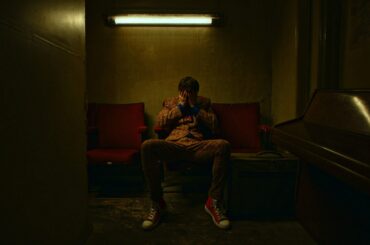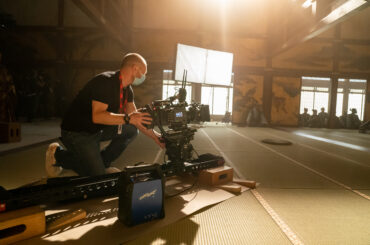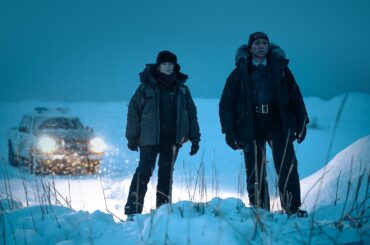Laurin Kelsey‘s first production gig was in High School. It was a student film or for the school news. She was the on-set props assistant for Stargate SG-1. Yes, her first gig is cooler than everyone else’s.
From there, Kelsey went on to study Theater Design at the University of Victoria and studied set design at the National Theater School of Canada.
Long story short, she’s had a unique journey toward her collaborations with one of the most entertaining filmmakers today, Mike Flanagan. The duo worked on The Midnight Club and most recently, The Fall of the House of Usher. The production designer paints a gothic picture, both realistic and surrealistic. The sets have character and history, making them the ideal thematic playground for horror set pieces.
During an interview, Kelsey spoke about how she got her start in the business and how she helped create the world of The Fall of the House of Usher.
Your first job was at 16 years old and on Stargate. How does that happen?
Actually, I was really lucky. I had a work experience week in high school and here they place you with different professionals and I just happened to have a contact through my guidance counselor on Stargate, and he was the prop master and he very kindly took me on for a week just to show me around and I worked in the art department and got a ton of exposure. It went so well that he hired me back, and I kept coming back, and then eventually that led me into doing a design degree and coming back to film after and so on and so forth.
That’s a great story. Even when you were on Stargate, did you know, this is where I want to be?
Yeah, it’s kind of funny. I think it worked out for the best, but I always felt a little bit out of place as a kid because I was type A organized, but also very creative and loved art. At least when I was growing up, it felt like if you’re type-A, you’re doing a professional job like a lawyer or a doctor or something very official, or you’re a wild free spirit artist and you’re insanely creative, and so to find something so quickly where it was like you need both sides to do this kind of a job felt like being home, this is where I’m meant to be because this is the only place I belong.
With the scale of The Fall of the House of Usher, what work did your type-A personality enjoy the most?
I think you kind of said it with the scale. You have to be extremely organized to execute so many sets and so many different locations, different time periods in such a short period of time. And we did a lot of very large builds for this. So, the type-A is being on schedule, being organized, and knowing when to let the creative side loose and when to reign it in because time is of the essence and you have to get a little bit more precise.
What were some of the more time-consuming builds?
They were all very time consuming in their own ways because they were also specific. They were all large, very large. Most of the sets take up an entire stage each, so Leo’s loft was a stage, the hospital was a stage and we had to change them over very quickly. I think just managing the schedule of it all and figuring out how to do that the most efficient way.
For example, the animal shelter that we built was not a large set. It was one of our smaller swing sets, but then myself and Michael Fimognari, who was directing that episode, we flipped it into Alessandra’s clinic. It was just a quick change of a couple walls, a couple doors and some paint, and obviously, set dressing. We had to get much more efficient about the builds and how we were going to make the most of them in the time that we had.
What would you say are some other tricks of the trade to really maybe use time to your advantage when you’re on a gig like this?
A great question. Well, there’s several elements that are really important for tricks of the trade, but I do think delegating is a very important skill and knowing when to let go. So knowing when to say maybe my good enough is actually still exceptional and that’s okay, or it’s okay to release that to someone else to finish because now I need to focus on this.
I think that’s actually a really hard thing for me to do. I come from a theater background as well, and in theater you are doing everything. You really are very hands-on. At a certain point, when you’re working on a show of this scale, you have to step back and let your team support you and not overdo it, otherwise you lose sight of the bigger picture.
Great work on the Usher house. It looks fantastic. How’d you pull off that unsettling decay over time in the series?
Well, that house is in a way very representative of Roderick, and I loved the transition that that house goes through. The house in the ’50s obviously starts out very optimistic feeling and you feel very much like he’s a child, he’s a kid, everything is good, the world is gold and rosy and yellow and bright and warm. And then to be able to shift that into the ‘sixties ’60s where his mom starts to crumble a little and you start to feel like things could be going a little bit off the rails and then all the way fast forward to the fully decayed broken down version.
I really think the house is Roderick and his soul and how he decays over time and becomes something that’s so far away from that original innocence. I loved that about the house. There’s a lot that went into the house, because obviously the fall of the house of Usher, Edgar Allan Poe, there’s a lot of imagery out there that’s very gothic that’s associated to his work.
What I thought was really fun but challenging was finding a suburban version of an Edgar Allen Poe home in a world where also his family has no money, so the house is not large and it’s not grandiose, but you have to have those little details. We went the route of doing a street of kind of older character homes so that I could pull in that 1890s gothic Victorian architecture without getting away from the suburbia that he wanted to portray. And then Roderick, everybody has a color in the usher family, Roderick’s color is gold and Madeline’s is lilac and purple. Those two colors playing together is in the house.
So you’ll notice the wallpaper in the living room has purple flowers with a gold background. So in the warmer ’60s we have nice warm lighting, everything’s bright and cheerful, but when it comes to decaying the mold and everything takes the yellow down and we play up the purples more. So, it’s kind of that house goes through quite a cool transition, a dramatic transition, and it was quite a fun challenge to try and find all the stages of that house.
As you said, you defined the characters with colors. Mind breaking them?
So Perry’s red and then we have, Leo is yellow, Camille is silver, Victorine is orange, Tamerlane is green, and Frederick is blue.
How did you pick those specific colors for those specific characters?
Yeah, that idea came from Mike. So I got the script and I gave it all a read-through and then in our, I want to say our first meeting, he said, “I want to give everybody a color.” And I thought, okay, I love in my work limiting my color palette a, especially when I read through and thought, oh my gosh, look at the time periods, look at the different levels of wealth,. We’re in a lot of worlds, and so one of the ways to make it feel cohesive for me is to limit what I do with color, so that I can at least tie a 1950s Victorian home to a 2023 glass apartment.
I got a little nervous with the colors, but my way of limiting in the rainbow of colors was to set a tone, which was to kind of lean into jewel tones and stay away from the primary colors. In the blue, it was more of a sapphire blue or a navy blue; in the yellows, it was a little bit more of a menagerie gold; and in the red, more scarlet red. And then that gave us more sort of cohesiveness within the worlds, within the larger world, within the colors.
Since this is an Edgar Allen Poe adaptation, when did you want to forgo realism and just really turn up the atmosphere?
I don’t know that I ever let go of the realism one, especially with Mike, but I definitely think that in some of the sets like Perry’s apartment and maybe Camille’s, you kind of take it a little bit further. You can characterize it a little bit bigger and bolder with it, because you want to kind of hit everyone over the head with it. Perry just being so obnoxious and having graffiti walls and a weird multicolored horse statue, he’s not a well-balanced person.
Any Edgar Allen Poe easter eggs?
There are little things in the ’70s bar. If you look at the stained glass behind Verna, it’s all Edgar Allen Poe stories. You have the black cat, the horse, and the raven all built into the glasswork. Or Perry, when he’s monitoring his party and he’s in that kind of weird dilapidated bathroom, the graffiti on the wall is part of the mask of the red death.
There’s a lot of pieces like that to look for, because obviously when we’re starting with such a massive set build, we’re working our way down and when we get to the part where we can really start to throw in those details, that’s when we can have fun. We can really add layer after layer of cool little pieces. If you look at the number of the house for Usher on his street, that’s a year associated with Edgar Allen Poe. Just details like that that are fun.
Was the club of death, let’s call it, a build as well?
A build, yeah. We resisted building that for a long time, because it just seemed so counterintuitive to build a warehouse. You think they’re everywhere, but they’re not everywhere with exactly those needs and requirements with the safety and the ability to do what we needed to do. We definitely held off as long as we could on building, making the plan to build that.
But it was a full stage at Vancouver film studios that we built this massive warehouse in and the bedrooms came off the sides practically. And then, one bedroom we flipped over from a bedroom to be that monitor room. It was a very challenging set because of all of the special effects that would then later take place. It goes through all its own transitions as well. I mean, once you do that scene from that episode, the set is kind of ruined. So, you got to be really careful about shooting order and how you execute it.
With all those extras and all the visual effects, especially the practical effects, what were some of the questions that you all had for Mike, the cinematographer, and effects team about requirements?
My Google search history was awful during that time period. I can imagine it now, “What does acid look like as it eats through skin?” A lot of departments were involved from a set perspective. The first thing was because we shot sequentially and then we had a data flip over a couple days to flip over to the aftermath.
Look, the aftermath was the hardest because that was where we had special effects, makeup, special effects. We had paint, set decorate, and construction doing breakdown of the set and the furniture. I think the most challenging thing was the realism of that. We did a lot of meetings of who was going to handle what because it had so many layers. I mean, special effects, makeup brought the dummies and the bodies and had to dress the bodies.
But then, what about the pooling of the blood and the acid on the floor? The blood is special effects, the acid is paint department. So having everybody strategically on top of each other and knowing how to do that while knowing how to make it look realistic took a lot of coordinating.
Also, once we dress up normally on a set, it’s like, “Put your armchair there. Okay, now we’re going to turn around, put the camera there. We’re going to shift the armchair over here.” Well, you can’t shift a bloody set of bodies with active liquid. You can do a congealed liquid that is movable like a little island, but that’s not the look we were going for. So, we also had to be really strategic about where we put the bodies, like up against the doors trying to escape or up towards the hallway, so we can still leave crew access the camera access and make sure that they’re not going to get destroyed during the shooting process.
Because we were so busy shooting when we did that scene, it was a lot of me going in, taking photos and texting them to Mike. We were emailing them to the producers and everybody, saying, “This is what it looks like, but we can go further.” It was making sure that we were really hitting the note because it had to look good.
To conclude, do you have go-to advice you usually share with aspiring production designers?
Usually, people are asking sort of what the standard route to get in is and what they do, the steps, and I think you can’t be too focused when you’re starting out in the industry on doing always the right thing. The main thing is to be a sponge, to learn, to meet people, to experience different challenges, try different things, build a good resume and get out there because film is such a collaborative art form and there’s no one way to do it.
I don’t believe there’s no one right program to take. Everybody comes from really cool, diverse backgrounds, and that’s what makes filmmakers so unique and so special. Everybody has their own perspective, so it’s kind of embracing your perspective and understanding there’s no one way to get there.
I do think something that’s quite important, and I’ve had it a few times, is dealing with other perspectives in the industry. Other people kind of break you down because there’s a lot of different personalities in film, and you’re not always going to approach things the same way. It’s about not letting someone tell you who you are and what you have to say and how you want to approach the art.
There’s a lot to learn, and you have to stay open to people who are more experienced and to learning new perspectives and new ways. But don’t let one person put you off or take you down. There are too many people in film that you come across. You’re not working with just one team for 40 years. You’re working with hundreds, if not thousands, of different people. So, you will at some point have someone ruin your day. It’s not personal, and you shouldn’t let it crush you.
The Fall of the House of Usher is available to stream on Netflix.





